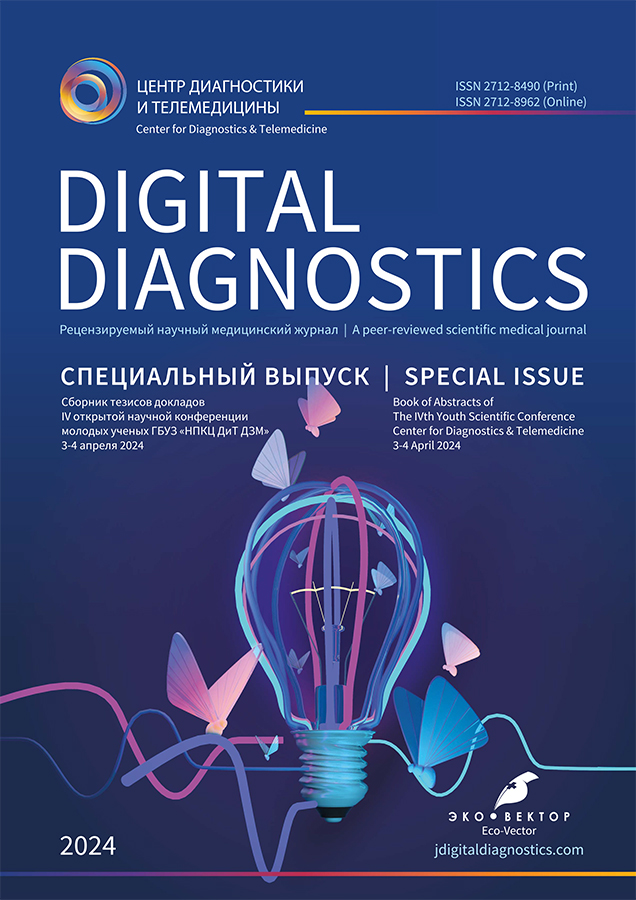Review of tissue-mimicking materials for anthropomorphic modeling of arterial vessels
- Autores: Abyzova D.I.1, Kodenko M.R.1
-
Afiliações:
- Scientific and Practical Clinical Center for Diagnostics and Telemedicine Technologies
- Edição: Volume 5, Nº 1S (2024)
- Páginas: 155-156
- Seção: Articles by YOUNG SCIENTISTS
- ##submission.dateSubmitted##: 14.02.2024
- ##submission.dateAccepted##: 22.03.2024
- ##submission.datePublished##: 03.07.2024
- URL: https://jdigitaldiagnostics.com/DD/article/view/626907
- DOI: https://doi.org/10.17816/DD626907
- ID: 626907
Citar
Texto integral
Resumo
BACKGROUND: In computed tomographic angiography, anthropomorphic specimens made of tissue-mimicking materials are used to improve the diagnosis of pathological changes in arteries. The design of test objects requires the selection of materials with properties that correctly reproduce the biomechanical and radiographic characteristics of the arterial wall. Tissue-mimicking materials used in modern specimens do not always take into account the conditions under which the arterial wall functions in vivo [1]. In addition, the selection of materials is required to simulate pathological processes, such as changes in the thickness of the arterial wall in the area of the aneurysm, simulation of thrombus [2]. The choice of tissue-mimicking materials to create a test specimen has a significant impact on the results of studies conducted with these materials.
AIM: The aim of this study is to ascertain the biomechanical and X-ray properties of tissue-mimicking materials for the anthropomorphic modeling of arterial vascular test objects.
MATERIALS AND METHODS: A literature analysis was conducted to investigate the potential of tissue-mimicking materials for the creation of arterial vessel test objects. The search query included the following keywords: abdominal aorta, aneurysm, CT-angiography, tissue-mimicking material, test objects, and mechanical properties of the arterial wall. The results of the literature review were used to investigate the biomechanical characteristics of the arterial vessel wall in a healthy state and in aneurysm. The advantages and disadvantages of different types of tissue-mimicking materials were analyzed. In the course of this analysis, the requirements for biomechanical and X-ray properties of tissue-mimicking materials were formulated. A ranked list of tissue-mimicking materials for the creation of anthropomorphic test objects of arterial vessels for studies by computed tomographic angiography was prepared.
RESULTS: During the course of the work, the requirements for biomechanical and X-ray properties of tissue-imitating materials for the creation of an arterial vessel test object were formulated. Further development of the topic will entail the expansion of the number of simulated pathologies and the search for universal materials suitable for the creation of multimodal test objects.
CONCLUSIONS: The results obtained can be used to improve arterial vascular test objects.
Palavras-chave
Texto integral
BACKGROUND: In computed tomographic angiography, anthropomorphic specimens made of tissue-mimicking materials are used to improve the diagnosis of pathological changes in arteries. The design of test objects requires the selection of materials with properties that correctly reproduce the biomechanical and radiographic characteristics of the arterial wall. Tissue-mimicking materials used in modern specimens do not always take into account the conditions under which the arterial wall functions in vivo [1]. In addition, the selection of materials is required to simulate pathological processes, such as changes in the thickness of the arterial wall in the area of the aneurysm, simulation of thrombus [2]. The choice of tissue-mimicking materials to create a test specimen has a significant impact on the results of studies conducted with these materials.
AIM: The aim of this study is to ascertain the biomechanical and X-ray properties of tissue-mimicking materials for the anthropomorphic modeling of arterial vascular test objects.
MATERIALS AND METHODS: A literature analysis was conducted to investigate the potential of tissue-mimicking materials for the creation of arterial vessel test objects. The search query included the following keywords: abdominal aorta, aneurysm, CT-angiography, tissue-mimicking material, test objects, and mechanical properties of the arterial wall. The results of the literature review were used to investigate the biomechanical characteristics of the arterial vessel wall in a healthy state and in aneurysm. The advantages and disadvantages of different types of tissue-mimicking materials were analyzed. In the course of this analysis, the requirements for biomechanical and X-ray properties of tissue-mimicking materials were formulated. A ranked list of tissue-mimicking materials for the creation of anthropomorphic test objects of arterial vessels for studies by computed tomographic angiography was prepared.
RESULTS: During the course of the work, the requirements for biomechanical and X-ray properties of tissue-imitating materials for the creation of an arterial vessel test object were formulated. Further development of the topic will entail the expansion of the number of simulated pathologies and the search for universal materials suitable for the creation of multimodal test objects.
CONCLUSIONS: The results obtained can be used to improve arterial vascular test objects.
Sobre autores
Dariya Abyzova
Scientific and Practical Clinical Center for Diagnostics and Telemedicine Technologies
Autor responsável pela correspondência
Email: theoriginaldoctor1963@gmail.com
ORCID ID: 0009-0007-4895-9033
Rússia
Maria Kodenko
Scientific and Practical Clinical Center for Diagnostics and Telemedicine Technologies
Email: m.r.kodenko@yandex.ru
ORCID ID: 0000-0002-0166-3768
Código SPIN: 5789-0319
Rússia
Bibliografia
- Mix DS, Stoner MC, Day SW, Richards MS. Manufacturing abdominal aorta hydrogel tissue-mimicking phantoms for ultrasound elastography validation. Journal of Visualized Experiments. 2018;(139):e57984. doi: 10.3791/57984
- Allard L, Soulez G, Chayer B, et al. A multimodality vascular imaging phantom of an abdominal aortic aneurysm with a visible thrombus. Medical Physics. 2013;40(6):063701. doi: 10.1118/1.4803497
Arquivos suplementares











